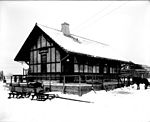Harriman Station, formerly known as Turner Station until 1910, was the first station on the Erie Railroad Main Line west of Newburgh Junction in Harriman, New York. Built adjacent to Grove Street in Harriman, one of the earlier structures built here in 1838 was a three-story hotel-train station combination. This station caught fire in 1873 and was replaced by a one-story wooden structure. That structure remained in use for decades before it began decaying and was replaced in 1911 with a new station on land donated by the widow of Edward Henry Harriman. A new one-story structure was built on the land. The station was maintained as a one-story depot with an adjacent monument dedicated to the work of Charles Minot. Minot was a director of the Erie Railroad who, in 1851, while his train was stopped at Turner, made the first railroad call by telegraph.
The station depot remained in use by the Erie through October 1960, when that was folded into the Erie-Lackawanna Railroad, which itself would fold in April 1976, as it was absorbed into the Consolidated Rail Corporation (Conrail). Conrail maintained passenger services until 1983, when that job was taken over by Metro-North Railroad. On April 18, 1983, the last passenger train left the Harriman station, as Conrail and Metro-North abandoned the tracks in favor of using the Graham Line (a high-speed freight line) for passenger and freight service. At that time, a new park & ride near New York State Route 17 in Harriman opened for the Port Jervis Line, the newly-realigned passenger service along the ex-Graham Line.
By the time passenger service transitioned to the Graham Line, the Harriman depot had been neglected for decades. The station depot remained on its concrete platform when the tracks were torn up on the old mainline. In 1996, workers removed the plaque attached to the Minot monument, but it was soon returned. However, the plaque was stolen shortly afterward and has not been recovered. The station depot itself was left in a decrepit condition as a result of the deterioration of its tiled roof. In 2006, the village of Harriman's building inspector ordered Norfolk Southern Railroad (the successor to Conrail and who owned the right-of-way) to either restore the building or demolish it. Norfolk Southern followed through with a demolition permit and in May 2006, the station depot was demolished by a front loader. The station remains were taken to a dump in Hillburn, New York.









